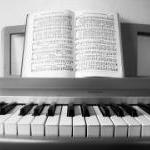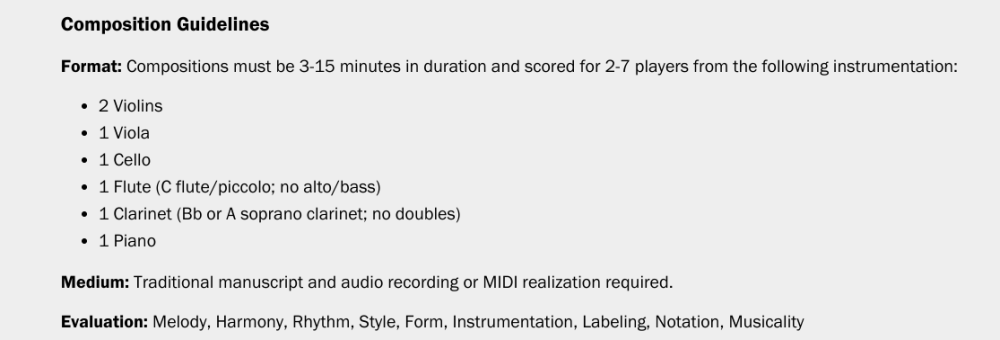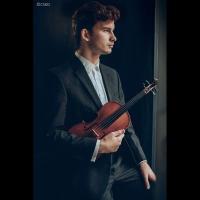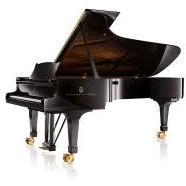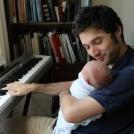Search the Community
Showing results for tags 'clarinet'.
-
Hey guys! I'm getting ready to start on my longest piece to date: a 10-minute chamber concerto featuring the oboe as the soloist. Instrumentation (subject to change): Woodwinds - Oboe, Flute, Bb Clarinet, Basson, Bass Clarinet Strings - 4 Violins, 2 Violas, 2 cellos, 2 DB Brass: French Horn, 2 Trumpets I am not sure where to start, so I was hoping to see if anyone had any resources they could recommend, such as words of advice, structural advice, instrumentation, etc. Thank you
-
A jazzy pastoral short piece I composed last winter. Enjoy!
-
Thank you to everyone who gave me feedback - this is the final piece! Program Notes: "Beauty for Ashes" draws inspiration from Isaiah 61:3: "To appoint unto them that mourn in Zion, to give unto them beauty for ashes, the oil of joy for mourning, the garment of praise for the spirit of heaviness; that they might be called trees of righteousness, the planting of the Lord, that He might be glorified." This piece reflects the contrast between sadness and joy, crafted through Louis's signature blend of traditional and modern harmony; inspired by jazz harmony and film scores. The main motif, a 5-measure phrase, ascends with leaps and scalar motion, symbolizing the climb towards joy and redemption. Secondary material navigates unexpected harmonic terrain, briefly shifting to evoke turmoil before returning to the main theme, restored and renewed. Louis uses modern harmony, secondary dominants, and modal mixture, creating a nuanced emotional landscape in which sorrow's depth and hope's radiance intertwine. The piece culminates in a triumphant, cinematic chorale finale, symbolizing hope and victory. Sweeping dynamics converge with moving harmony lines, resolving to a radiant major 7th chord, evoking flourishing "trees of righteousness" – roots deepened by sorrow, branches stretching toward light. Duration: 5:22 Instrumentation: 1 Flute, 1 Bb Clarinet, 2 Violins,1 Viola, 1 Cello
-
This is my rough final draft of a piece I've been working on for a string quartet with clarinet and violin. My main thing right now is getting everything connected and refining my harmony. I wrote some sections that are just there and have no relation to the piece. I am also trying to follow my modern-classical-lush sound in the harmony, but I haven't perfected it. If you could please look it over, maybe mark it up, give some harmony/chord progression suggestions, and anything else, I would greatly appreciate it. Some "rules" I've learned for getting that sound - every chord gets a 7th (at least) - trying to always use the full chord - Use functional tonal harmony, and color special moments with chromaticism (iii7 a lot, modeal mixture, and secondary dominants)
-
Hello all - I am trying to write a composition that follows these guidelines. I have a basic motif already, and I was wondering if anyone had any suggestions on how to proceed. I've never written for this exact ensemble before (2 violins, 1 viola, flute, and clarinet) and I'm aiming for a 3.5-4 minute piece. Are there any formulas that might help, or anything orchestration-related that you might suggest?
-
Trying something crazy - it might not work, but it's fun to try new things I have a piece that I've arranged for band/orchestra and I was thinking it'd be cool to do a virtual band type recording Here's the link to the project drive - https://drive.google.com/drive/folders/1cYfbUEXY9swZi-ZbNb6YI8oMmblUlloM?usp=sharing I have a piano track playing the melody at the correct tempo to keep everyone on track *IF YOU'RE PLAYING ANY OTHER INSTRUMENT OTHER THAN ALTO SAX, THOSE RECORDING INSTRUCTIONS/RECORDING ORDER ARE FOR YOU - ALTO SAX PLAYERS DISREGARD* Let me know if you have any questions
-
Hey everyone, this is a project I did for my Theory: Intro to Harmony class. We started with just a chord progression, then added texture and a melody. I'd love to hear any feedback, and if anyone thinks of a title, please let me know
- 12 replies
-
- 1
-

-
- jazz arranging
- clarinet
-
(and 2 more)
Tagged with:
-
Not sure what game soundtrack this would fit, but it sounds like it could maybe be music for a loading screen on Animal Crossing or something.
-
Hi! I am a newcomer to this forum. It's really fascinating to see many young composers sharing their pieces here. I guess if I would have the right to be called a composer at all, so I would like to present a piece I recently finish here. For me this piece is about despair and meaning, and their dialectic relationship. It's in c minor in all four movements to present the gravity of sadness, especially in our time. It's in a four movement structure, and here is the brief synopsis: 00:05 First Movement: Allegro ma non troppo Modified Sonata Form .One is despair to find the meaninglessness of existence. One would like to find a dream to flee but fail. One is defeated by the despair. 21:06 Second Movement: Scherzo: Presto, Sonata Form. Defeated, one starts to free the self to crazy thoughts, though still reasonably (with its tonal structure ). After this one instead finds moment of calmness. 30:27 Third Movement: Adagio Meastoso - Fugue: Andante ma non troppo. One starts to dwell into the root of despair. One uses different kinds of approach and finally finds something hopeful. But despair soon arises, and hope defeated is worse than hope never appeared. One ends in utter sadness but finally knows the root of it. 45:40 Fourth Movement: Allegro con moto . Sonata Form/Sonata-Rondo. Seemingly to know the root of despair, one pretends to be free of it, although the nightmare keeps reminding the one its presence. After the combat between despair and meaning, one finally knows that without despair there won't be meaning at all, therefore accepting the despair and ends in tranquility. It ends with Beethoven Op.135 since it perfectly fits here, and it is one of my favourite piece, if not the most (The other being his op. 131). It seems like a long piece but I just cannot stop it. I have too many things to tell. I really would like to know whether this piece worth other's attention or not, so I would be extremely grateful to have other comments, whether it's positive or negative. Update on 20/02/2023: Structural Plan of the Third Movement added: Mov 3 Structural Plan.pdf
-
This is my "Soliloquy for Clarinet No. 21". Here is the link to my previous soliloquy for clarinet, composed in March 2020: https://www.youngcomposers.com/t39457/soliloquy-for-clarinet-no-20/
-
It has been awhile since I posted anything, so I thought I post this little piece here. Although I completed the piece back in January, I haven't made any of the score yet, until now. Also, this is the first piece that I wrote for piano and clarinet. I think it turned out nice. Let me know what you think! PS: the detuning throughout the piece is just for an aesthetic purposes, it kinda gives like a distant memory/nostalgia feel to it, i guess. Update 1.2 After a long time stalling, I finally revised the piece according to some feedback that I've received. Here are the changes: Changed a little bit of the cadenza and changed the clarinet to an A clarinet. Revised the score to match the changed version. Updated the recording to match the revised version. Thank you once again for the feedback!
-
This is a piece I wrote recently about a nervous auditioner (I think that’s the right word) in an audition for area or district band. It is supposed to be more on the theatrical side with some instruments representing people. There are four movements, each representing a part of the audition process. I will explain each one in depth:
-
This is a piece i made in my free time, i was experimenting with different instruments and forms, as such it's more of an educational composition. Any critique feedback appreciated. youtube link:
-
Good evening! Here is a short woodwind duet in sonata form I wrote a few years ago with a new video on YouTube, hope you like it! YouTube video
-
This is my "Soliloquy for Clarinet No. 20". Here is the link to my previous soliloquy for clarinet: https://www.youngcomposers.com/t36672/soliloquy-for-clarinet-no-19/
-
A piece for two Bb clarinets and one Bb Bass clarinet. Transposed notation.
-
Hello all, Here is the first movement of my Fantasy in D Minor, scored for pairs of Oboes, Clarinets, Horns and Bassoons. It is written in sonata form, and I tried to share the material between the different instruments. It took me a long time to write - I hope you enjoy it!I - Lento.mp3
-
The idea behind the first part of this movement is the growth of material from one note to its full statement. The clarinet, trumpet, violin, vibraphone, and trombone all play there own material treated in this manner. Each statement introduces a new note to their material. The bassoon and bass provide a sonic backdrop to this unravelling. I plan on expanding on this idea in other works -this was a fun idea to work on. Hope you enjoy.
-
I started this quintet with the intention of entering this into a competition -so, I've been working pretty intently on it (to the point that it's all I think about). Here are the first 2 movements: 1. Andante: The first movement serves as a sort of introductory movement. The movement utilizes the short two bar theme presented in the opening (this theme also permeates large portions of the work as a whole). The theme is presented in all voices, leading to the establishment of a 'hopefully' hypnotic pattern -through which I play with the theme and introduce contrapuntal material. The structure is ABA'. 2. Allegro Con Fuoco: This is the movement so far that I've spent the most time on -and this is revision number 4. The opening two bars introduce an ostinato pattern that is taken up by ALL instruments within the quintet. This movement is meant to be faster than what I have set. I've slowed it down to give more attention to detail. 3. Adagio Semplice: To compliment the 2nd movement -and in stark contrast texturally- this movement is more of a mediation and prayer-like movement. The movement is slow and contemplative. At any rate, I'll post the final 2 movements once I've finished them. Hope you all enjoy these experiments.
-
This is my first composition I wanted to put on here, and my first one I will count (All the others were either practice, arrangements, or incomplete and I wasn't comfortable counting them). So I guess this my Op. 1! It is for Flute, Clarinet in Bb, and Trumpet in Bb. It is very short, but I feel it's pretty okay for me atleast. I tried to make the trumpet stand out so I put the trumpet melody in Bb first, then Eb, then in G twice. For the final trumpet melody, I made the Clarinet and Flute switch from F to G major for a nice ending.
-
4) The Magic Songs.mp3 Magic Songs.pdf This post is about the fourth movement of my piece called “Quiquern”. To read about the first few movements and about this piece in general, go here. Fragment 4: The Magic Songs Famished and delirious, Young Kotuko and the girl set out alone into the blizzard to find food for the starving village. As the dark and the cold and hunger devour them, the two children rave and hallucinate, unhinging themselves from the realm of men and into the realm of gods. As they descend, they sing songs of magic, songs buried deep in their memories, in their blood. Their voices rise and fall with the frozen wind. And through this silence and through this waste, where the sudden lights flapped and went out again, the sleigh and the two that pulled it crawled like things in a nightmare — a nightmare of the end of the world at the end of the world. The girl was always very silent, but Kotuko muttered to himself and broke out into songs he had learned in the Singing–House — summer songs, and reindeer and salmon songs — all horribly out of place at that season. He would declare that he heard the tornaq growling to him, and would run wildly up a hummock, tossing his arms and speaking in loud, threatening tones. To tell the truth, Kotuko was very nearly crazy for the time being; but the girl was sure that he was being guided by his guardian spirit, and that everything would come right. She was not surprised, therefore, when at the end of the fourth march Kotuko, whose eyes were burning like fire-balls in his head, told her that his tornaq was following them across the snow in the shape of a two-headed dog. The girl looked where Kotuko pointed, and something seemed to slip into a ravine. It was certainly not human, but everybody knew that the tornait preferred to appear in the shape of bear and seal, and such like. It might have been the Ten-legged White Spirit–Bear himself, or it might have been anything, for Kotuko and the girl were so starved that their eyes were untrustworthy. They had trapped nothing, and seen no trace of game since they had left the village; their food would not hold out for another week, and there was a gale coming. A Polar storm can blow for ten days without a break, and all that while it is certain death to be abroad. Kotuko laid up a snow-house large enough to take in the hand-sleigh (never be separated from your meat), and while he was shaping the last irregular block of ice that makes the key-stone of the roof, he saw a Thing looking at him from a little cliff of ice half a mile away. The air was hazy, and the Thing seemed to be forty feet long and ten feet high, with twenty feet of tail and a shape that quivered all along the outlines. The girl saw it too, but instead of crying aloud with terror, said quietly, “That is Quiquern. What comes after?”
-
My master's degree is starting to draw to a close, and I'm very aware that every piece I write now will be one of the last while I still have my tutor. For that reason, I've really tried to push myself beyond my current boundaries wherever possible. This piece, while not incredibly 'contemporary' sounding I suppose, in some ways represents the culmination of my efforts and explorations while at this institution. I've pushed my harmonies and chord progressions as far as I'm personally willing to right now, and also used some new string techniques that I'd not really explored before. Some of this piece, especially the second half, is definitely among my favourite music I've ever written. I've still kept to my usual style of working with very short bits of material and seeing where I can take them, but this piece is roughly divided into three or four smaller sections which have their own separate ideas as well. I've also become very interested lately in sounds that 'morph' over the course of a single note. Usually, that just means fading multiple instruments in and out on the same note. I feel that this is an area that isn't adequately explored in a lot of the more widely played contemporary repertoire, especially in more amateur-aimed music. This piece will be performed at the start of May by a professional ensemble (including a very skilled concert pianist, fortunately). It'll be conducted, which is why I put the piece in this section. I've put it on Soundcloud as well if that playback is working better than this site for whatever reason. There's a couple of really minor changes between the score and the recording, because once you start polishing the score in Sibelius you often kind of ruin the playback.

